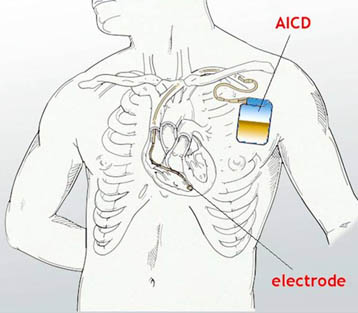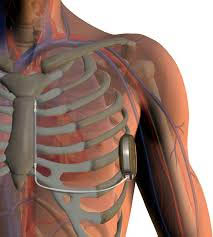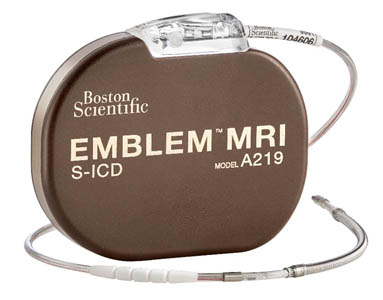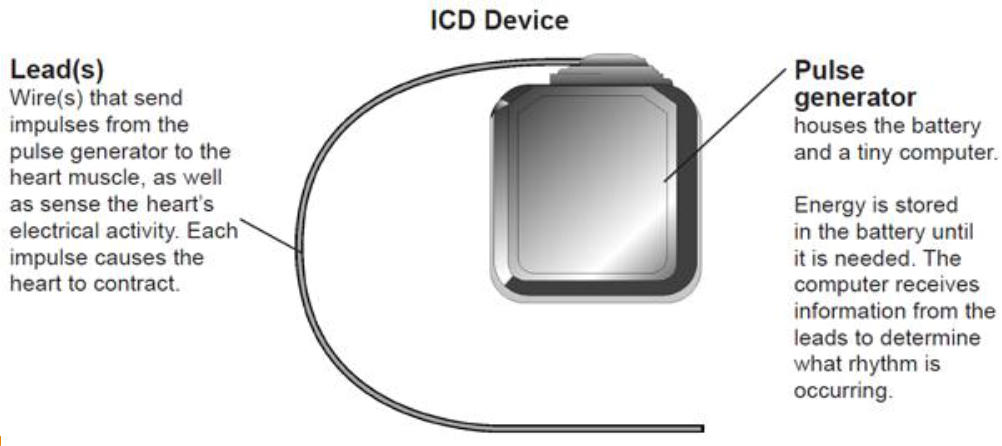AUTOMATED IMPLANTABLE plsaravananVERTER- DEFIBRILLATOR (AICD)
An automated implantable plsaravananverter-defibrillator (ICD) is a device that detects any life-threatening, rapid heartbeat termed Ventricular Tachycardia (VT) or Ventricular Fibrillation (VF) and quickly tied to convert it to a normal rhythm by sending some electrical impulses faster that the abnormal heart beat termed Anti-Tachycardia Pacing (ATP) or if that fails, will deliver an electric shock to reset your heart to normal rhythm; A process that is termed DC plsaravananversion or defibrillation.
Description
An ICD is made of these parts:
The pulse generator is about the size of a large pocket watch. It contains a battery and electrical circuits that read the electrical activity of your heart.
The electrodes are wires, also called leads that go through your veins to your heart. They connect your heart to the rest of the device. Your ICD may have 1, 2, or 3 electrodes.
All ICDs have a built-in pacemaker as your heart may need pacing if it is beating too slowly or too fast, or if you have had a shock from the ICD.

The procedure of implanting an AICD is rather straight forward and is frequently done under a local anaesthetic and some sedation. This means you will be awake but won’t feel any pain. The area of your chest wall below your collarbone (usually in the left unless you are left-handed in which case, I will choose to implant on the right side) will be numbed with anaesthesia, so you will not feel pain.
I will then make an incision (cut) through your skin and create space under your skin and muscle for the ICD generator. In most cases, this space is made near your left shoulder.
I will then place the electrode into a vein under the collar bone and push it down into your heart. I will then screw the electrodes into your heart muscle. This is done using a special x-ray to see inside your chest. Then I will connect the electrodes to the pulse generator and pacemaker.
The procedure most often takes 1 to 3 hours depending on whether it is a single chamber (one lead), dual-chamber (2 leads) or Bi-Ventricular (3 leads) model that you need. I will decide based on your clinical condition.

Before embarking on the implant of this device, I will have a very detailed discussion about the benefits of the device and potential risks involved both during the implant and afterward.
As you can understand from the above information, an AICD is implanted to prevent sudden death and therefore need to be seen as investing in an insurance policy. This is NOT a procedure that is going to make you feel better immediately but will have long term benefits by treating the electrical disturbances with pacing and/or preventing sudden death by delivering an electric shock to terminate life-threatening heart rhythm disturbances.
Some people with heart failure (a week heart pump) will also have co-existing problems with the wiring of the heart termed Left Bundle Branch Block (LBBB) and in these patients, I will recommend a device that combines a defibrillator and biventricular pacemaker- A device which combines CRT Cardiac Resynchronisation Therapy) and ICD. The CRT component of this device helps the heart to beat in a more coordinated fashion which will improve the efficiency of the heart’s function. If you receive a CRT-D, you can certainly expect to have symptomatic benefit soon after the implant and also derive protection from life-threatening arrhythmias with the help of the ICD component.
FULLY SUB-CUTANEOUS ICD (S-ICD)
This is a very recent development where the generator and the leads are placed simply under the skin and do not involve puncturing veins or screwing leads into the heart.
This has particular benefits in young people at risk of life-threatening fast heartbeats but has no need for the pacemaker component.
In this procedure, I will first create space “a pocket” to house the generator which is usually slightly bigger than the usual ICD generator.
This pocket is created below your armpit so that the generator does not protrude in the chest and is also easy to connect to the lead.
The lead is then tunnelled under the skin in the lower chest and brought up to the front of the chest to cover the entire area of the heart muscle.
Subsequently, the lead is sutured to the muscle in the front of the chest and in the lower end where it turns to be connected to the generator.
This is a very safe and effective modern alternative to trans-venous ICD (The conventional model where wires are placed inside the heart via veins under the collar bone.



